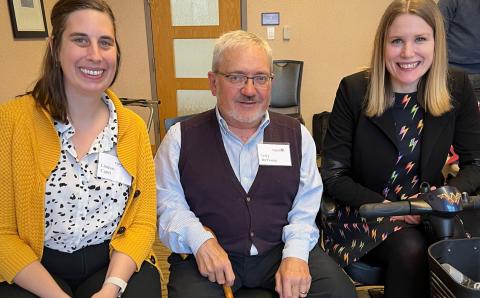One clear outcome of the pandemic is that many have entrenched themselves firmly in their beliefs, often in opposition to the beliefs firmly held to by others. This does not bode well for our society, because people who are entrenched don’t listen well and are more likely to see others and their beliefs as a threat. Some who have firmly entrenched themselves are Christians, and this entrenchment sometimes emerged in opposition to other believers. This does not bode well for the kingdom of God or for the body of Christ. The church is called to be united and to represent Christ in the world. In our actions and words, supported by the work of the Spirit, we are the way others will meet Christ, hear his call, and come to know they are God’s dearly loved children.
One of my students recently wrote, “We are recovering from the biggest isolation and breakdown of community that everyone in our lifetime has experienced.” In the context of this isolation and division, we can show the world a different way. This is an unprecedented opportunity for the church to demonstrate the reconciling and transforming power of God’s love.
The Love Command
Christ, the head of the body, is very clear about our obligation to love others. Indeed, God commands us to love each other (John 13:34-35). This is how others will know we follow him. The apostle John reminds us to love one another (1 John 4:7-8). Anyone who loves has been born of God and knows God. Anyone who does not love does not know God, because God is love. Others will come to know God through the love we communicate.
Many Christians intend to offer love and care to those around them. Their intentions are often recognized, and the love and care they offer is often recognized, received, and experienced. History clearly testifies to the immense good done by Christians acting in the name of Christ. However, history also has shown that there have been times when loving intentions backfired, and the people we sought to love and care for experienced harm as a result of our good intentions and our intention-rooted actions.
Many outside of the church hold a deeply rooted suspicion of Christians. They believe the church has a legacy of harming the marginalized and that the church has deservedly lost power and influence. In fact, many believe the church has forfeited the right to speak and lead in Western culture because Christians have been at the forefront of most significant marginalizations in the West (e.g., gender bias, withholding women’s rights, slavery, apartheid, abusive residential schools for First Nations children, LGBTQ discrimination).
To many both inside and outside the church, Christians do not appear to be very loving. This is a problem of epic proportions. Has the church failed the love command?
Studying Care
I began my Ph.D. program by exploring the communication of care in education literature. I discovered that educational care was part of a larger body of literature described as “care theory,” which I reviewed over two years, and recognized that care theory had a lot to teach Christians about communicating love. The testimony of history and the perceptions of those outside the church clearly demonstrate that good-hearted, well-intentioned Christians have caused harm to others. There is often a disconnect between our intentions and our impact. Care theory has a lot to offer the church as a result.
Contested Conceptualizations: The literature recognizes that care is a contested concept: it means different things to different people. And how one defines care significantly affects how one practices care. Are caring intentions and caring actions enough? Or does care need to be recognized and responded to?
Two Care Needs: At the heart of the care theory literature is the recognition that all human beings have two care needs: the need to care for others and the need to be cared for by others. This was a very important foundation for my research because this is part of what it means to image God: we were created for love—to love others and to be loved by others.
Care Is a Relationship: Care is not just a virtue, nor is it simply a behavior. Care is a relationship between people. Offering care and receiving care are each part of the process of communicating care. When we offer care, we enter into a relationship.
Care Requires Completion: It is not enough to simply intend care or to act in ways intended to communicate care. Care must be completed. It must be recognized and responded to by the person we are seeking to care for. Without completion, there is no care. Caring intentions and caring actions are necessary, but insufficient. This distinction might help explain the church’s frequent failure to obey the love command. It is not enough to intend to love or to do things that are meant to communicate our love and care for others. The other person, in most cases, must recognize we are trying to offer love. If they do not recognize and respond, then we have not yet successfully communicated love. We must pay attention to their perceptions and responses. If our intentions are authentic, we must find ways to re-communicate our love.
Defining Care: Because care is a contested concept, it is important to be clear about how we define care. We often experience tension when it comes to caring for or loving others. Do we love them for who they are, or for who they could become? Loving them for who they are might imply we support and endorse everything they are and believe. Yet who they become is not up to us. We can influence others, of course. But we can’t control or change them. If a change emerges, it will come through the work of the Spirit. I define care as “a relationship where the one caring supports the well-being, flourishing, and autonomy of the cared-for, and where both relationship partners recognize and assent to what is happening.” The final line of the definition might be the most important: the relationship is not established until both participants recognize that care was offered, and the cared-for responds. I believe this definition has significant value for the modern church. Love seeks the well-being and flourishing of the other. But it can only happen in the context of relationship.
Establishing a caring relationship changes everything. Care theory clearly shows that once care has been successfully communicated, a caring relationship forms. And once a caring relationship has formed, the nature of the relationship changes. The cared-for now trusts the one caring and believes that they have their best interest at heart. This allows them to receive criticism and to be asked tough questions. A caring teacher can challenge and critique. A caring parent can discipline. A caring friend or colleague can speak the truth in love. It is only after Jesus has gained the trust of the woman caught in adultery by saving her from stoning that he can tell her what she needed to hear: go and sin no more (John 8). How the cared-for perceives the one caring makes all the difference. If the person you are offering care to recognizes and trusts your intentions, they are likely to receive and respond. If the person you are offering care to does not recognize your caring intentions, and does not accept your actions as caring, the care you offer will not be successfully communicated. This is an essential distinction for the church. Often our intentions are good, and our actions are well-intended. But because we are not focused sufficiently on how others perceive our intentions and actions, we might believe we are being caring when the other person is not experiencing care.
Some Considerations
So what should we—both corporately as the church and individually—consider when we wish to offer love and care to people? Here’s what my research shows:
Intent vs. Impact: When we consider our own actions, we tend to overfocus on our intentions. We believe our intentions are good, so we assume our impact also will be positive. When we respond to the actions of others, however, we tend to overlook and mistrust intent and focus on impact.
Perception vs. Behavior: Every behavior makes sense to the behaver in the moment of behaving. Behavior is a symptom of perception. In order to understand where others are coming from, we need to look past their words and actions to discern their underlying beliefs and perceptions. We can’t change their behavior. But we might be able to influence their perceptions, which might cause them to change their own behavior.
Receptive vs. Projective Empathy: Projective empathy occurs when we assume we know how someone else feels because we have considered how we would feel if we were in their situation. As a result, we believe we know where they are coming from. Receptive empathy recognizes the only way we can truly understand how someone feels is to watch them and ask them directly—to hear their words and truly be able to stand in their shoes.
Offering Love vs. Successfully Communicating Love: Loving intentions and loving actions are necessary for successfully communicating love, but they are insufficient. It is not enough to intend to love, or to act in ways that are loving. Love must be recognized, accepted, and responded to in order for it to transition from offered love to successfully communicated love.
The Issue vs. the Person: When we disagree with others, we tend to equate the issue with the relationship. If we disagree with what they believe, we often dislike the person. Sometimes this is temporary, in the heat of the moment. Sometimes it is permanent. We need to find a way to keep the two separate. Even if we disagree with someone else, we may not overlook their humanity or the fact that they are an image bearer and a sibling in Christ.
Posture vs. Position: When we disagree with someone, it is helpful to distinguish between our position (what we believe) and our posture (how we act toward them). If our posture is inappropriate, our position is unlikely to be heard or to have influence. It is possible to maintain one’s own position while authentically demonstrating a posture of authentic listening and hospitality. This is not easy, but it is necessary.
The Bystanders and the Next Generation: When we are involved in a disagreement, we tend to focus on the participants. We often forget there are others around. The way we behave might affect the bystanders in ways that far exceed the significance of the issue itself. This is particularly important for the church. Having worked with adolescents and young adults in Christian communities for most of my life, it is clear to me that one of the main reasons for the decline of the church is how the next generation perceives the way the previous generation has handled conflict and treated people.
Remembering Who Our Enemies Are: Far too often we act as if the people with whom we disagree are our enemies. They are not. Our enemies are not flesh and blood, but Satan and the powers of darkness (Eph. 6:12). Human beings are not our enemies. They might be victims in need of help. They might be patients in need of healing. They might be allies in a spiritual war. But they are never our enemy, even when it feels as if they are.
Recognizing Relational Reciprocity: If we are going to communicate love successfully, we can only do so by entering into relationship, even when we disagree. Our love will not be recognized and responded to if there is no relationship. If there is no relationship, we will not be able to influence. We need a relationship in order to offer critique and ask tough questions that will actually be received. But relationships are reciprocal. We need to be able to receive criticism and face tough questions from others, too. And reciprocity carries with it a key risk: it is quite possible that we also might be changed by the process.
Seeking to Influence Through Love
Most faith traditions have some variation of the golden rule: do unto others as you would have others do unto you. If we want to love others, we should act in ways that offer love. Care theorist Nel Noddings, drawing on receptive empathy, suggests we should take it one step further: to “Do unto others as they would have done unto them.” Communicating care is not about the perceptions of the one caring, but the cared-for, and those perceptions are profoundly shaped by the nature of the shared relationship.
Our ability to love others comes from God, not from us. We are commanded to love others, reflecting God’s love to others. We don’t need to judge. That is for God to do. We don’t need to save people. Jesus already did so. We don’t need to change others. That is the work of the Spirit. We can, however, be part of the process of growth in change, influencing others by caring for them as dearly loved brothers and sisters, beloved children of God.
Discussion Questions
- How have you defined love and what it means to love?
- What are some historical examples of the church’s failure to love? How do you think the non-Christian world has reacted to these failures?
- What do you think about the claim that it is not enough to intend love but that to successfully love someone they must also recognize and respond to our loving actions?
- Which of the ideas in the author’s list of considerations struck you the most? Which ones do you want to learn more about, and maybe even implement?
About the Author
Sean Schat (sschat@redeemer.ca) is an assistant professor of education at Redeemer University in Hamilton, Ont. His research focuses on the communication of educational care. He and his family attend Jubilee Fellowship Christian Reformed Church in St. Catharines, Ont.









